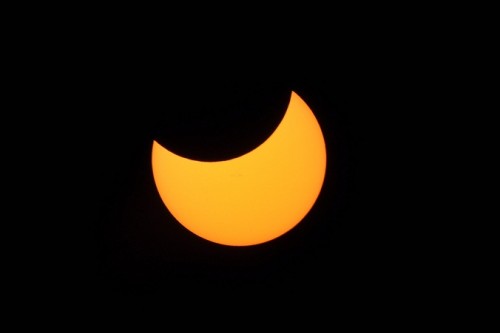The Israel Space Agency and the Israel Astronomical Society will hold guided observations for the occasion

20.3: Spring starts tomorrow, a solar eclipse today, and a new moon is also close at birth - Equinox 2015
For the first time in two years, it will be possible to witness a solar eclipse from Israel this Friday, March 20. Those who miss the current event will have to wait until June 2020 to be able to witness a solar eclipse from Israel again. Around the cosmic event, the Israel Space Agency at the Ministry of Science and the Israel Astronomical Society will conduct guided observations for the audience towards the sun with the help of special telescopes and accompanied by explanations about the solar eclipse phenomenon.
Dr. Yigal Fatal, chairman of the Israeli Astronomical Society, explains: "A solar eclipse occurs when the moon passes between the earth and the sun and hides part of the sun or all of it. The current eclipse is a total solar eclipse, but in Israel we will see it as a partial one. The total eclipse will be visible from the North Sea region, northern Scandinavia and the Arctic. For there to be a total eclipse, it is not enough for the moon to be at its birthplace, but also very close to the plane where the earth orbits the sun."
The maximum number of eclipses per year is 7. This year another solar eclipse will occur on September 13, which will only be visible from South Africa and Antarctica, while on September 28 a total lunar eclipse will occur, most of which will also be visible from Israel.
In Israel, the peak of the eclipse will be around 12:00 when the moon will hide about 7% of the sun's surface, depending on where in the country you are - when the greatest eclipse will be in Kiryat Shmona and the smallest in Eilat. The maximum time when the total solar eclipse will be visible at its peak will be two minutes and 47 seconds at a point located about 300 kilometers east of Iceland in the Norwegian Sea.
The eclipse will begin when the moon begins to hide the sun for viewers on the western shores of Greenland as well as in the northern part of the Atlantic Ocean. The shadow will be cast on the northern part of the European continent, when the full path of the shadow will pass between Greenland towards the northwest, north of Scandinavia and up to the North Pole. The edge of the shadow will be along North Africa and Northwest Europe and Russia. Israel is close to the edge of the shadow, so a partial eclipse will be seen here.
For those who want to watch the eclipse - watching the sun without protective equipment can cause irreversible damage to the eye to the point of blindness. To watch the eclipse safely, you must equip yourself with safety measures such as welding glass number 14 or special glasses for viewing the eclipse. Another way is to cast the figure of the sun on the floor - punch a hole in the center of a piece of tin or a piece of cardboard with a diameter of about one millimeter and cast the figure of the sun passing through the hole on the floor.
The observations, which are part of the "Looking Up" annual observation series, will be held on March 20 from 10:30 a.m. to 13:00 p.m. at the following observatories: Givatayim Observatory, Maale Adumim Observatory, the Druze Space Center in Birka near the High School for Sciences and Leadership, Technode Hadera, The observatory at the Ilan Ramon Center in Teiba, and at the Ilan Ramon Center in Be'er Sheva, Ben Gurion University. The entrance is free of charge.

8 תגובות
There was no solar eclipse
Will it be possible to see the solar eclipse from the Kfar Saba area?
In June 2020 there was another defect, but in Israel also in 2020 other issues will fill the news.
From the NRG website: "... in the arctic region where the eclipse will be full. It is also a special eclipse because it will occur exactly on the first day when the sun rises in the north after six months of winter night. In this respect, the current event only occurs once in 500 years."
A solar eclipse is a solar eclipse and a lunar eclipse is a lunar eclipse.
By the way, just for curiosity's sake, there are more solar eclipses in a year than lunar eclipses, but they are considered rare for the simple reason - a solar eclipse is visible only in a limited area (at least in its full part), while the lunar eclipse is seen from half of the Earth's surface
For all the astrologers it is the case that there is no God and the State of Israel is not eternal. It is a fact that Bibi caused mass Shabbat desecration at the Kotel, and yet he won. And corruption and stagnation endanger the existence of the state.
And actually the eclipse for me... it says "lunar eclipse" and not "solar eclipse". 🙂
There is a partial defect in the article.
On the one hand it is written: "Whoever misses the current event will have to wait until June 2020 to be able to witness a solar eclipse from Israel again."
On the other hand, it is written: "This year, another solar eclipse will occur on September 13, which will only be visible from South Africa and Antarctica, while on September 28, a total lunar eclipse will occur, most of which will also be visible from Israel."